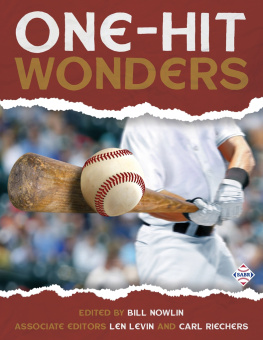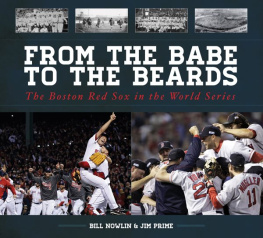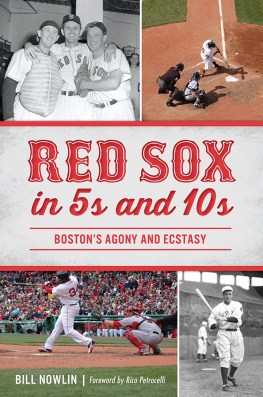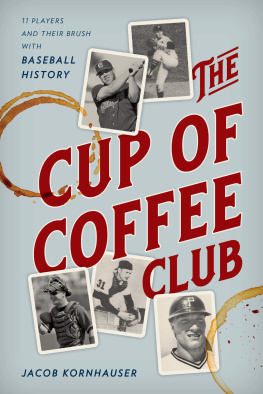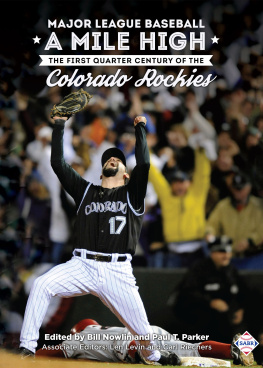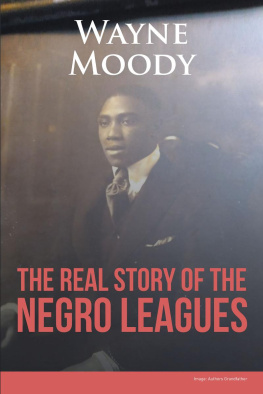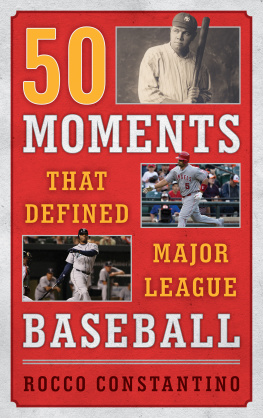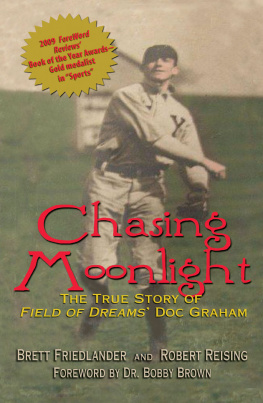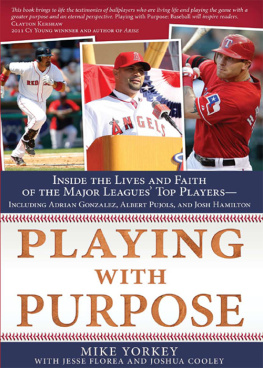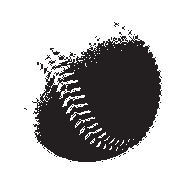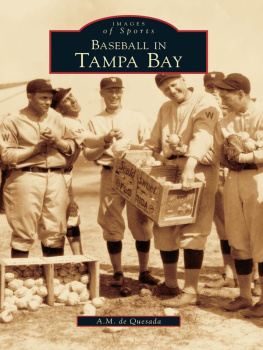

One-Hit Wonders
Edited by Bill Nowlin
Associate editors Len Levin and Carl Riechers
Society for American Baseball Research, Inc.
Phoenix, AZ
Copyright page copy:
One-Hit Wonders
Edited by Bill Nowlin
Associate editors Len Levin and Carl Riechers
Copyright 2021 Society for American Baseball Research, Inc.
All rights reserved. Reproduction in whole or in part without permission is prohibited.
978-1-970159-56-1 One-Hit Wonders ebook
978-1-970159-57-8 One-Hit Wonders paper
Library of Congress Control Number: 2021915561
Front cover image by Dreamstime
Back cover images depict the actual baseballs hit for base hits by Larry Ray, Cory Aldridge, and Dana Williams.
Book design: Rachael E. Sullivan
All baseball card images courtesy of the Topps Company, unless otherwise noted. Thanks to Michael and Linda Hanks, and to Bruce Erricson for images supplied.
Copyright 2021 Society for American Baseball Research, Inc.
All rights reserved. Reproduction in whole or in part without permission is prohibited.
Cronkite School at ASU
555 N. Central Ave. #416
Phoenix, AZ 85004
Phone: (602) 496-1460
Web: www.sabr.org
Facebook: Society for American Baseball Research
Twitter:
CONTENTS
ONE-HIT WONDERS
By Bill Nowlin
The idea for this book came from an interview I conducted with Bobby Guindon on February 23, 2018. His one hit was a double for the Boston Red Sox on September 27, 1964. With eight career at-bats, Guindon holds a .125 career batting average. In the course of the interview, he mentioned that he had been featured in a book titled One-Hit Wonders. I looked it up online and bought a copy. It was written (and I believe self-published) by George Rose in 2004. The book noted a website and provided an email address. Fourteen years later, neither of them worked.
Rose said there had been approximately 200 players in the one hit wonder club and his book provided capsule stories on 75 of them. He said there were an additional 104 listed at the end of the book but he must have forgotten to include the promised list. It isnt there. I have a 2009 edition of the book; perhaps it was included in the 2004 edition but omitted in the later one.
In any event, when I asked Tom Ruane of Retrosheet if he could prepare a list for me, he came up with 1,389 names. His list embraced the years 1875 through 2017. The resulting list ran from Fernando Abad to Ed Zmich. Abad, a relief pitcher, appeared in 363 major-league games from 2010 with Houston to 2017 with the Red Sox; his record was 8-27. He batted only nine times, with one hit in 2012. He did pitch for the San Francisco Giants again, in 2019, and got into 21 games but never had even one plate appearance. Zmich, a left-handed pitcher like Abad, had a career that had started exactly 100 years earlier than Abads, in 1910 for the St. Louis Cardinals. He relieved in seven games and started in six; his record was 1-5 (though he was undefeated 1-0 in 1911 after an 0-5 first year). He eked out one base hit in 17 at-bats. Zmich also drove in a run, but in a different game.
Roses book didnt include any players prior to 1930. Its not clear why.
Looking only at the list Tom sent, there were exactly 500 one-hit wonder players before 1930. But many of them were pitchers. If Roses mission was only to look at position players, and only for the years 1930 through, say, 2004, one comes up with a figure that is indeed around 200.
All in all, there are no small number of major leaguers who produced one hit and only one hit in the course of their major-league careers. Some had very brief careers. Some had longer ones. There were 69 players who had only one plate appearance. And produced a base hit in that one opportunity. There are 90 players through 2018 who appear to have retired with a lifetime 1.000 batting average.
Of course, that means that of the 1,389 one-hit wonders, some 1,320 players had more than one opportunity. Fred Gladding had 68 plate appearances (and 63 at-bats) but had only the one base hit. Its probably not surprising that Gladding was a pitcher, and that he played in the days before the DH, but he had a long career, pitching in 13 seasons from 1961 through 1973. His one hit came in his ninth year. It was a single for the Astros in the first game of a July 30, 1969, doubleheader against the Mets, an RBI single in the top of the ninth inning. It seems he caught the Mets bullpen at just the right time. His run batted in was the fifth of 11 runs scored that inning.
The nonpitcher with the most plate appearances was center fielder Skeeter Shelton of the 1915 New York Yankees. He played in 10 games, stepped into the batters box 43 times, and got a single in the sixth of his 10 games, the second game of an August 28 doubleheader in Detroit. He was 1-for-7 that day (and 1-for-40 in his career.)
Second least-productive for a position player was third baseman Bill McNulty, who played for Oakland in 1969 (17 plate appearances 10 of them resulting in strikeouts and no hits) and again in 1973 in the final game of his career, a single off Nolan Ryan. He had 12 plate appearances in 1973, for a total of 29.
Others (all of them pitchers) who had 50 or more plate appearances: Wei-Yin Chen (64), Aaron Heilman (54), Rick van den Hurk (54), and Will Sawyer (50). We have to knock Chen off our list, however. He collected six base hits in 2018.
Some of the one-hit wonders had a home run as their one hit. In fact, 22 of them did. Of the 22, 13 of them were pitchers. Not all of them had careers that ended in 2017. Nolan Fontana, for instance, was a second baseman with the Angels who homered in the ninth inning of the May 26 game in Miami; the Angels lost, 8-5. He continued to play in 2018 and had the misfortune (?) of getting one more base hit. Hes now a two-hit wonder and will not be mentioned again in this book.
Lets look at a few other stats:
Tripled for their only base hit: There were 22 such players. Fourteen were pitchers.
Doubled for their only base hit: There were more, as one would expect, than those who tripled for their only hit. In fact, 179 players counted a double as their only hit. Bobby Guindon and 178 others. Of the 179, 108 of them were pitchers.
Runs batted in: There are obviously numerous ways to drive in a run without a base hit. Walk (or get hit by a pitch) with the bases loaded. Hit a sacrifice fly. Hit into a fielders choice. A pitcher, Gene Woodburn of the 1911-12 Detroit Tigers, collected four RBIs, but had only one base hit (it was not a grand slam.) There were 13 different players who each had three RBIs but also only one base hit. Only one of them Mark Worrell hit a homer and drove in three. Its perhaps of some marginal interest that there were also two brothers named Worrell who were both pitchers. Todd had two base hits in his career; his brother Tim had eight. Some 69 batters drove in two runs (not necessarily all with their one base hit, of course.)
Other players with three RBIs are Frank Boyd, Matthew Brown, Carlos Casimiro, Webbo Clarke, Ensign Cottrell, Ed Gerner, Fred Gladding, Steve Ontiveros, Pat Paige, Al Raffo, Tony Tonneman, and Fred Waters.
Runs scored: One could score hundreds of runs without even getting one base hit. Just keep walking, getting hit by pitches, reaching on errors, etc., and then get driven in. Don Hopkins of the 1975 and 1976 Oakland As scored 25 runs but had just one hit. He was, perhaps not surprisingly, often a pinch-runner. Hopkins appeared in 85 games, but played a position (outfielder) in only 21 of them. He had only eight plate appearances, and just the one base hit. The hit came in his 60th game a single to lead off the eighth inning in a July 22, 1975, game at Detroit. He was forced at second base on a subsequent at-bat. It was not a great loss; the As held a 16-4 lead at the time.
Next page
